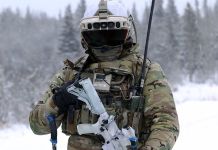F-35 stealth fighter jets launched from the HMS Queen Elizabeth aircraft carrier has been monitoring the maneuvers of Russian ships and aircraft in the Mediterranean Sea, according to footage shared by the Russian defense ministry on Monday.
Ships and submarines of the permanent task force of the Russian Navy in the Mediterranean Sea and aviation units, including MiG-31K fighter jets and an Il-38 anti-submarine aircraft, have been conducting joint exercises in the eastern Mediterranean since June 25.
A UK strike group led by the aircraft carrier, including F-35 fighter jets, in turn, is conducting an operation against the Islamic State terrorist group in the region.
The footage from the Admiral Makarov frigate participating in the maneuvers first shows the F-35 jet’s all-round flight over the Russian ships.

Then a pair of Russian Tu-22M3 bombers accompanied by a Su-35 fighter is featured flying over the frigate, with the F-35 fighter also moving in their direction at a lower altitude.
The combat alert mission of the UK strike group is set to last through Wednesday.
Overall, the UK operates about 138 aircraft of this type, including the fighters based on the carrier Queen Elizabeth currently staying in Mediterranean waters, according to available data.
The F-35 Lightning II is a fifth-gen, single-engine, nuclear-capable, all-weather stealth multirole fighter. Their basic armaments include a 25 mm four-barrel air gun, missiles and air bombs on four internal and six external hardpoints.
Earlier, as EurAsian Times reported, the HMS Queen Elizabeth had sailed from Portsmouth for her maiden operational deployment at the heart of the UK’s Carrier Strike Group in May. It is the largest and most powerful vessel ever built for the British Royal Navy.
“This deployment is a major strategic moment for the UK,” Angus Lapsley, director-general for International and Strategy at the Ministry of Defence, had stated in an online press briefing.
The fifth-generation 65,000-tonne aircraft carrier will be escorted on its maiden trip by a strike group made up of two destroyers, two frigates and tanker and storage ships. More than 30 aircraft will also embark across the task group including F-35 jets, helicopters as well as Royal Marines commandos.
The fleet is scheduled to visit 40 nations, including India, Japan, the Republic of Korea and Singapore, in a deployment covering 26,000 nautical miles. This has been described by the Ministry of Defense as “the largest concentration of maritime and air power to leave the UK in a generation.”
Although the carrier strike group will sail across the Mediterranean Sea and the Black Sea, where it will take part in joint exercises and security operations with NATO, its final destination will be the Indian and Pacific oceans, as part of the UK’s post-Brexit tilt towards the region.
“There is a very clear signal here that Britain wants to play a bigger part in that region. That’s a role which is not just military, but it’s also about political engagement, it’s about multilateral engagement, it’s about economic engagement, but definitely, it is a role for UK’s defense,” Lapsley admitted.
Meanwhile, vice-admiral Ben Key, who is the Chief of Joint Operations at the Ministry of Defense, described the carrier deployment as a “really tangible demonstration of a different way of understanding how the contemporary operational and security space is now … and the manner we need to operate within it.”
Foreign Office’s director for Defense and International Security, Samantha Job, said that showing military strength is part of the agenda of “Global Britain,” and that the government wanted to project the UK as a leading member of the North Atlantic Alliance.




